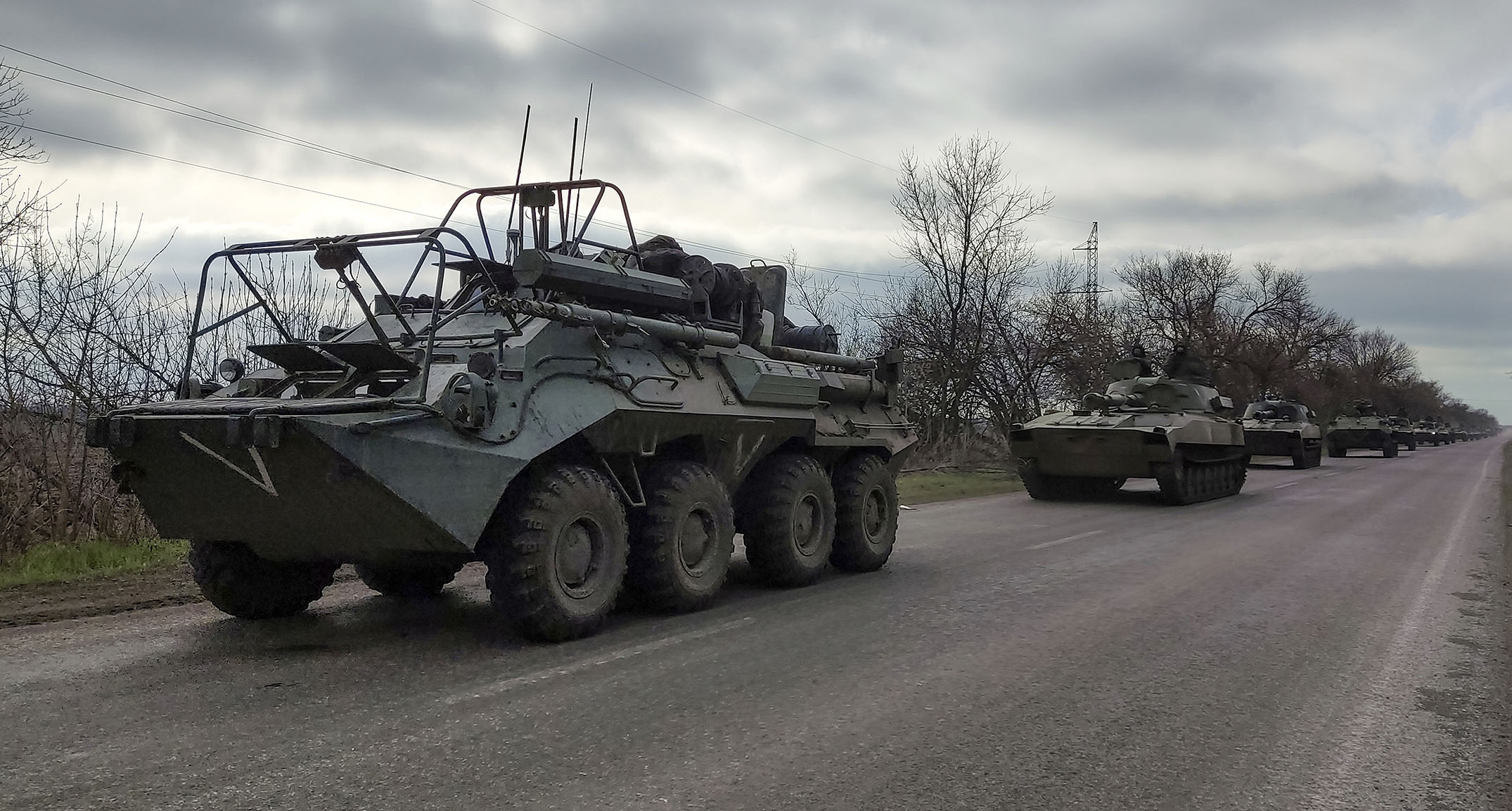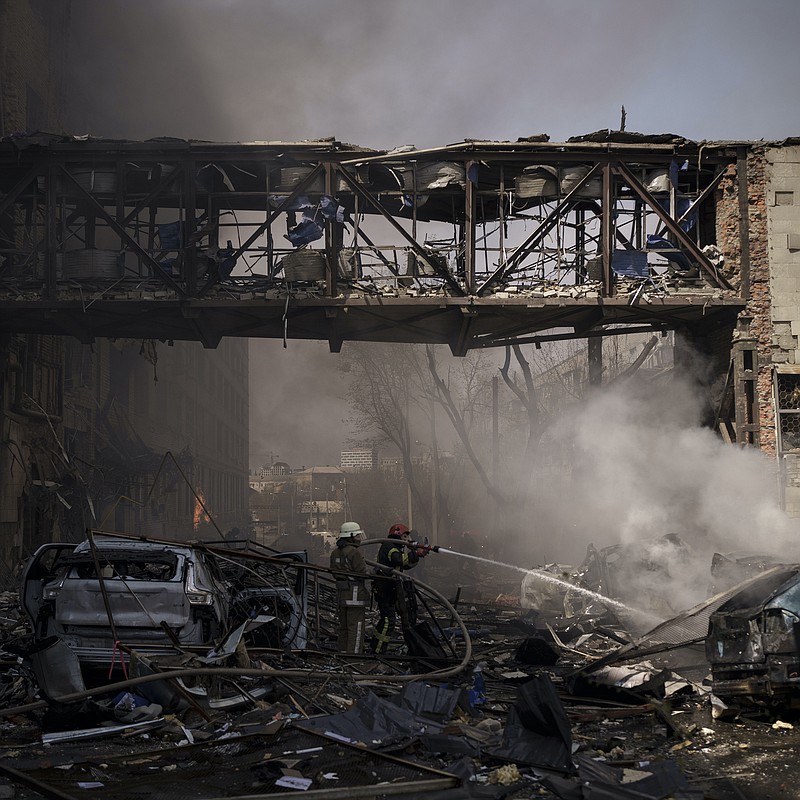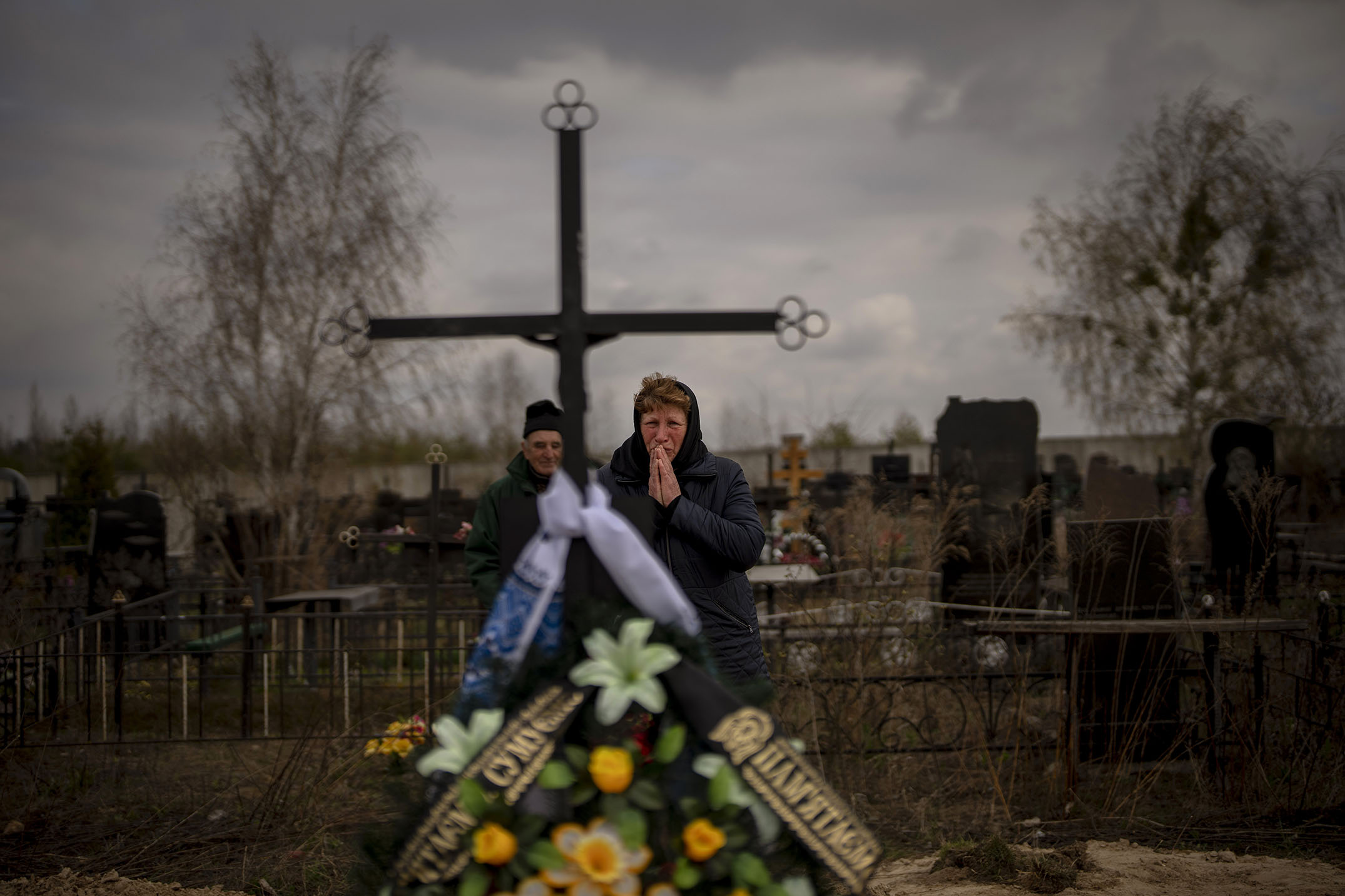KYIV, Ukraine — Russian forces launched scattered attacks on Kyiv, western Ukraine and other areas Saturday in a reminder to Ukrainians and their Western supporters that the whole country remains under threat despite Moscow’s pivot toward a new offensive in the east.
After the loss of its Black Sea flagship and allegations of Ukrainian aggression on Russian territory, Russia’s military command had warned of renewed missile strikes on Ukraine’s capital. Officials in Moscow said they were targeting military sites, a claim repeated — and rebutted by witnesses — throughout 52 days of war.
Each day brings new discoveries of civilian victims. As Russia prepared for its next offensive, a mother wept over her 15-year-old son’s body after rockets hit a residential area of Kharkiv, a city in northeast Ukraine. An infant and at least eight other people died, officials said.
In the towns and villages just outside Kyiv, authorities have reported finding the bodies of more than 900 civilians, most of them shot dead, since Russian troops retreated two weeks ago. Smoke rose from the capital again early Saturday as Mayor Vitali Klitschko reported a strike that killed one person and wounded several others.
The mayor advised residents who fled the city earlier in the war not to return.
“We’re not ruling out further strikes on the capital,” Klitschko said. “If you have the opportunity to stay a little bit longer in the cities where it’s safer, do it.” The strike hit a sprawling area on the southeastern edge of the capital that contains a mixture of Soviet-style apartment blocks, newer shopping centers, big-box retail outlets, industrial areas and rail yards.
Russian Defense Ministry spokesman Igor Konashenkov said an armored vehicle plant was targeted.
He said the plant was among multiple Ukrainian military sites hit with “air-launched, high-precision, long-range weapons.” As the U.S. and Europe send arms to Ukraine, the Russian strategy could be aimed at hobbling Ukrainian defenses ahead of what’s expected to be a full-scale Russian assault in the east.
It was the second strike in the Kyiv area since the Russian military vowed last week to step up missile strikes on the capital. Another hit a missile plant Friday.
In the weeks since Ukrainian forces repelled the Russian attempt to seize Kyiv, residents have been streaming back into the city. But the window-rattling blasts Saturday were a reminder that the war is far from over.
The Russian missiles hit the city just as residents were emerging for walks, as foreign embassies planned to reopen and as other tentative signs of prewar life started surfacing.
The Ukrainian president’s office reported missile strikes and shelling over the previous 24 hours in eight regions across the country.
Russia’s cruise missiles, the principal weapon in Saturday’s attacks, can strike over long distances at sites throughout the country. Through the day Saturday, air raid sirens wailed in Kyiv; and overnight, the distant, dull thuds of air-defense missiles exploding could be heard in the sky over the city.
“Our air defenses are working, our military is defending us, but all the same there were explosions” in a southeastern district of the capital, Klitschko said in a statement on Telegram.
In the statement, Klitschko said Kyiv remains a target for Russia despite the defeat of the ground-assault force, which retreated hastily, leaving in its wake burned tanks, its own war dead and hundreds of civilian bodies lying in the streets.
The governor of the Lviv region in western Ukraine, which has been only sporadically touched by the war’s violence, reported airstrikes on the region by Russian Su-35 aircraft that took off from neighboring Belarus.
In apparent preparations for its assault on the east, the Russian military has intensified shelling of Kharkiv, Ukraine’s second-largest city, in recent days. Friday’s attack killed civilians and wounded more than 50 people, the Ukrainian president’s office reported.
On Saturday, an explosion believed to be caused by a missile sent emergency workers scrambling near an outdoor market in Kharkiv, according to journalists from The Associated Press who were at the scene. One person was killed, and at least 18 people were wounded, according to rescue workers.
Kharkiv Mayor Ihor Terekhov said Saturday’s toll was three dead and 34 wounded.
Nate Mook, a member of the World Central Kitchen NGO run by celebrity chef Jose Andres, said in a tweet that four workers in Kharkiv were wounded by a strike. Andres tweeted that staff members were unnerved but safe.
Austrian Chancellor Karl Nehammer, who met with Vladimir Putin last week in Moscow — the first European leader to do so since the invasion began Feb. 24 — said the Russian president is “in his own war logic” on Ukraine.
In an interview on NBC’s “Meet the Press,” Nehammer said he thinks Putin believes he is winning the war and that “we have to look in his eyes and we have to confront him with that, what we see in Ukraine.” Nehammer said he confronted Putin with what he saw during a visit to the Kyiv suburb of Bucha, where more than 350 bodies have been found along with evidence of killings and torture under Russian occupation. He added that “it was not a friendly conversation.” Ukrainian President Volodymyr Zelenskyy said the continuing siege of the port city of Mariupol, which has come at a horrific cost to trapped and starving civilians, could scuttle attempts to negotiate an end to the war.
“The destruction of all our guys in Mariupol — what they are doing now — can put an end to any format of negotiations,” he said.
Later, in his nightly video address to the nation, Zelenskyy said Ukraine needs more support from the West to have a chance at saving Mariupol.
“Either our partners give Ukraine all of the necessary heavy weapons, the planes, and without exaggeration immediately, so we can reduce the pressure of the occupiers on Mariupol and break the blockade,” he said, “or we do so through negotiations, in which the role of our partners should be decisive.” Zelenskyy said the situation in Mariupol remains “inhuman” and that Russia “is deliberately trying to destroy everyone who is there.” Konashenkov said Saturday that Ukrainian forces had been driven out of most of the city and remained only in the Azovstal steel mill.
Capturing Mariupol would allow Russian forces in the south, which came up through the annexed Crimean Peninsula, to fully link up with troops in the Donbas region, Ukraine’s eastern industrial heartland.
Russian Maj. Gen. Vladimir Frolov, whose troops have been among those besieging Mariupol, was buried Saturday in St. Petersburg after dying in battle, Gov. Alexander Beglov said. Ukraine has said several Russian generals and dozens of other high-ranking officers have been killed in the war.
On Saturday, a Russian shell hit an oil refinery in the city of Lysychansk in the Luhansk region, setting off a large blaze, according to Serhiy Haidai, the regional governor. “Shelling continues in residential areas of Lysychansk, and locals are asked to remain in shelters,” he wrote in a message posted on social media.
Zelenskyy said Saturday that Russian forces had been expelled from nearly 1,000 villages, towns and cities of varying sizes across Ukraine. Most of the liberated communities lie in the northern parts of the country and suffered extensive damage to buildings and infrastructure during the month-long Russian occupation.
Zelenskyy estimated that 2,500 to 3,000 Ukrainian troops have died in the war, and about 10,000 have been wounded. The off ice of Ukraine’s prosecutor general said Saturday that at least 200 children have been killed, and more than 360 have been wounded.
Russian forces also have taken captive some 700 Ukrainian troops and more than 1,000 civilians, Ukrainian Deputy Prime Minister Iryna Vereshchuk said Saturday. Ukraine holds about the same number of Russian troops as prisoners and intends to arrange a swap, but it is demanding the release of civilians “without any conditions,” she said.
Ru ss i a ’s wa r n i n g of stepped-up attacks on Kyiv came after it accused Ukraine on Thursday of wounding seven people and damaging about 100 residential buildings with airstrikes in Bryansk, a region bordering Ukraine. Ukrainian officials have not confirmed hitting targets in Russia.
FOOD CHALLENGES
As Russia gears up for its military offensive in eastern and southern Ukraine, the United Nations warned Saturday that closures of ports on the Black Sea could trigger a global food catastrophe that yields starvation, mass migration and political instability.
Ukraine’s silos are brimming with grains that in a normal year help feed 400 million people. But the supply chain has been disrupted by the war, with ports unable to operate normally near the heart of a war zone.
“You pull that off the market,” David Beasley, executive director of the U.N. World Food Program, said from Ukraine’s western city of Lviv, and “you begin to realize you have a perfect storm coming our way.” Beasley spoke at the end of a four-day visit to Ukraine to explore ways to deliver food to about 1 million Ukrainians trapped in cities and other areas cut off by Russian forces and to examine the wider threat to global food markets.
The food supply challenge within Ukraine was not complicated, he said.
“We’ve got the food; we’ve got the money,” Beasley said. “Give us the access.” The challenge for global food supplies is keeping open the southern ports of Odesa, Chornomorsk, Yuzhny and Mykolaiv on the Black Sea coast, which are in Ukrainian hands but are threatened by Russia’s anticipated offensive.
Beasley said he had spoken by phone and set out his concerns in writing, but that the Kremlin had not responded to any of the United Nations’ worries.
“We have made no headway whatsoever,” he said.
“This is where the international community has got to come in and make some very serious decisions about protecting ports for humanitarian purposes and opening up ports for the whole world,” he added, “because the whole world is going to pay a price if we don’t get the ports open.” Some 45 million people in 38 countries are “knocking on famine’s door as we speak,” thanks to the cumulative toll of wars, droughts and the covid-19 pandemic, Beasley said. The Ukraine war’s effect on food prices and fuel and shipping costs looks set to drive that number up and limit the U.N. capacity to help.
Operating costs of the U.N. food program have risen by $71 million a month, Beasley said.
“That means we will be feeding 4 [million] to 5 million people less a year because of the cost increase alone,” he said.
The short-term problem is a financial one, Beasley said, adding that rich countries and the world’s billionaires needed to step forward to plug the funding gap, which is around $8 billion.
The more concerning threat is the longer-term challenge to global food markets. Ukraine’s farmers could still produce a harvest that would help feed the world’s hungry if the war were to stop now, he said — but not if the southern ports and Black Sea shipping routes remain shut.
Beasley said he is urging leaders of the Group of Seven leading industrial nations and other governments to get unused agricultural land back into production to offset the possible loss of Ukrainian and Russian food supplies, but he warned that global food market shortages and further dramatic increases in food prices would spell disaster for poor countries.
“You will have famine, death and starvation,” he said. “You will have the destabilization of several nations, and you will have mass migration.”
Information for this article was contributed by Adam Schreck, Mstyslav Chernov, Yesica Fisch and Robert Burns of The Associated Press and by Andrew E. Kramer, Marc Santora, Matina Stevis-Gridneff and Nick Cumming-Bruce of The New York Times.
 A Russian military convoy moves down a highway Saturday in an area controlled by Russian-backed separatist forces near Mariupol in eastern Ukraine. Mariupol, a strategic port on the Sea of Azov, has been besieged for more than six weeks. Ukrainian President Volodymyr Zelenskyy said the situation in Mariupol remains “inhuman” and that Russia “is deliberately trying to destroy everyone who is there.” (AP/Alexei Alexandrov)
A Russian military convoy moves down a highway Saturday in an area controlled by Russian-backed separatist forces near Mariupol in eastern Ukraine. Mariupol, a strategic port on the Sea of Azov, has been besieged for more than six weeks. Ukrainian President Volodymyr Zelenskyy said the situation in Mariupol remains “inhuman” and that Russia “is deliberately trying to destroy everyone who is there.” (AP/Alexei Alexandrov)Gallery: Images from Ukraine, month 2

